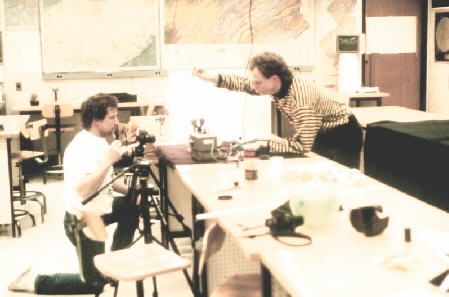Stop-Motion Technique

Students Preparing to Take a Stop-Motion Photograph
Jeff Gibbs (left) and Lee Knauss (right) set up a camera on a tripod and position the strobe light (between them), a light reflector for diffuse illumination, and the speaker on the table top. The speaker detects the sound of the popping balloon by generating a pulse of electric current, which activates the an electronic circuit which was built by Lee Knauss. This circuit triggers the strobe light to flash. The time delay between the action and the exposure is determined by adjusting the distance between the object making the noise and the speaker -- the greater the distance, the longer the time delay. When the components for the photograph are all in place, the room lights are turned off, the camera shutter is opened, and the balloon is pricked with a pin. The noise from the burst moves the speaker's cone which triggers the flash from the strobe. The camera shutter is then closed and the room lights are turned back on to prepare for the next photograph. The appropriate exposure is achieved through systematically moving the components of the scene: the camera placement, lens opening, strobe placement, object placement, and speaker placement. Through systematically varying the scene components, sufficient experience is gained to be able to achieve successful stop-action photographs with relatively few failures.